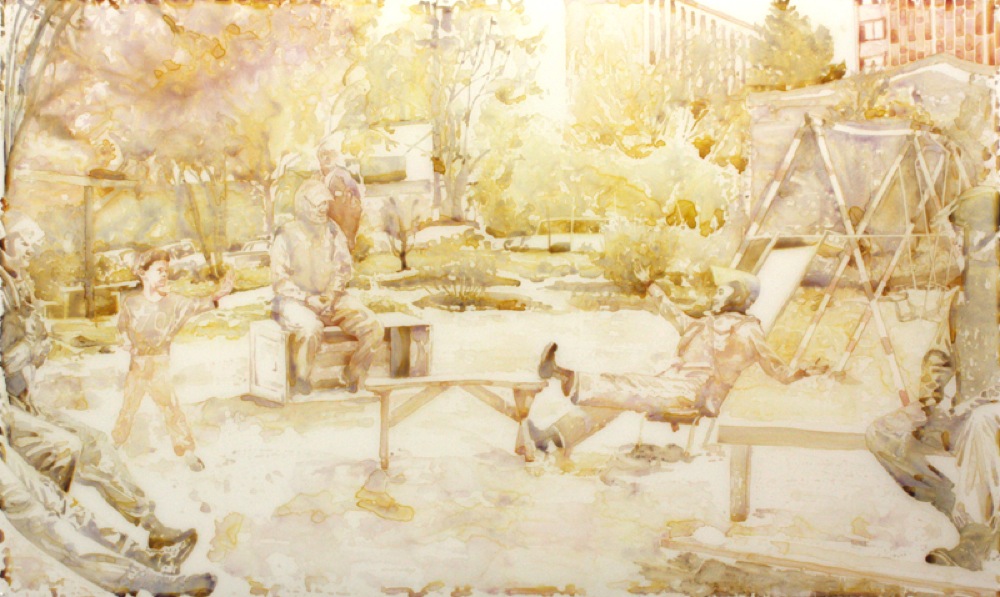In 1969, radical activists in Berkeley, CA took possession of an underused parking lot owned by the University, with an eye to creating a public park. University officials objected to the takeover, and then-governor Ronald Reagan sent in officers from the California Highway Patrol and Berkeley Police Force to clear the park, touching off a day of violent clashes known as “Bloody Thursday.” One student, James Rector, was shot and killed by the police. For decades, People’s Park has been the site of ongoing conflict between the University and a community of protestors and park users. Today, the former parking lot continues to be used by the public and is now home to basketball courts and community gardens, a reversal of Joni Mitchell’s classic lament about paving paradise.
In a series of watercolors, Oakland artist Anna Ludwig explores the complicated past and present of People’s Park. With sharp figures revealed in layers of dreamy, gauzy color, her paintings mimic the way that history leaves its marks on the physical world.
Events leave traces of themselves—faint traces, ephemeral but indelible—on the places where they occur. I’m especially interested in the physical sites of political action. My current work examines People’s Park, a battered but still-functioning relic of the 1960s. Today People’s Park, with its seedy atmosphere, homeless population, and history of police brutality, is a stain on the Berkeley landscape. But a stain can be many things: dirt or filth, yes, but also artistic mark. Also evidence.
The stains on and surrounding People’s Park are contradictory. Its creation planted the seed of a green revolution in public urban spaces. The violent police response solidified a loss of trust in the state. The Park’s political potential has been defanged by the slow violence of time and poverty, and has been manipulated by the University to give the impression that the idealism of the 1960s was futile and naive. Now, the site is both an emblem of failed 1960s activism and the source of a glimmering afterimage, a reminder of the energetic clash between establishment and counter-culture.
My palette is romantic, fairytale-like, but tart and acidic. Some of the paints are mixed by hand from dirt collected at the site. I work flat, allowing the water to pool and the pigments to form layers of sediment.
The stain on People’s Park seeps beyond the park’s geographical boundaries. The idea of fluid, seeping edges informs my watercolors of the park. The images are fleeting, shimmering, interrupted by oily traces left by my own fingers. The mythology of the park is like an imprint, a degraded mimeograph image overlaying the present, causing snags, delays, interference.
Completing the People’s Park project has made me hyperaware of the police violence and controversy surrounding the Occupy Oakland movement. When I started exploring the history of People’s Park, I was surprised to learn that tanks had rolled down Telegraph Avenue and that a helicopter had sprayed CS9 gas on the Berkeley campus. Then, in November 2011, I saw police piling out of buses to teargas several blocks of Occupy protestors in downtown Oakland. That night I had the sense that I was inside one of my paintings.

